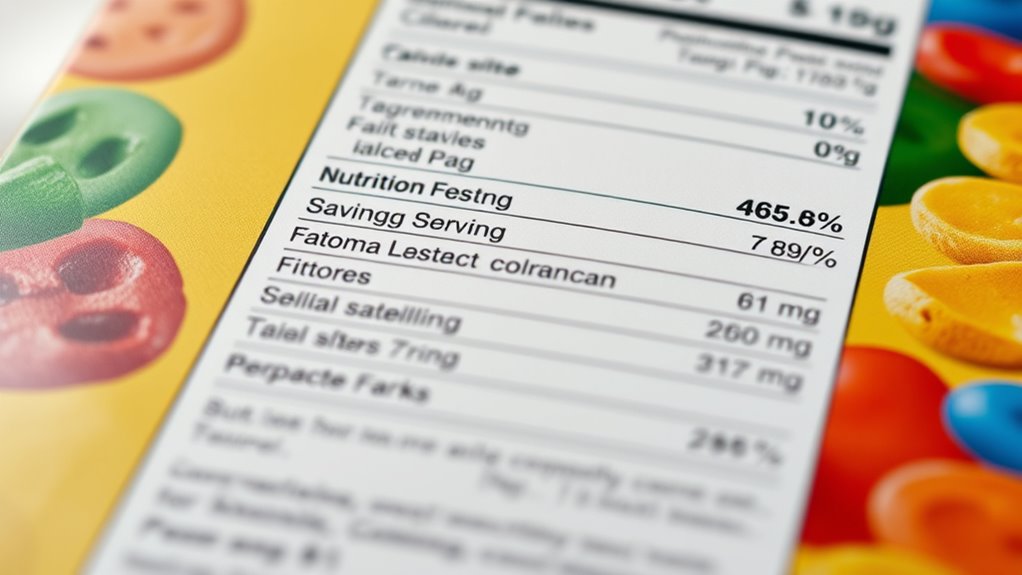To understand nutrition labels, start by checking the serving size to see how portions are measured. Look at calories first to gauge energy content, then review macronutrients like carbs, fats, and proteins. Scan the ingredients list for added sugars and additives, and check percent daily values to see if a nutrient is high or low. Comparing products helps you choose healthier options. Keep exploring to learn how these details work together for smarter food choices.
Key Takeaways
- Start by checking the serving size to understand the portion the nutrition info is based on.
- Review calories and macronutrients (carbohydrates, proteins, fats) to assess energy and nutrient intake.
- Examine the ingredient list, noting first items and any added sugars or additives.
- Use % Daily Values to determine if a nutrient is low or high relative to daily needs.
- Compare similar products by standardizing serving sizes and nutrient content for accurate assessment.
Understanding Serving Sizes
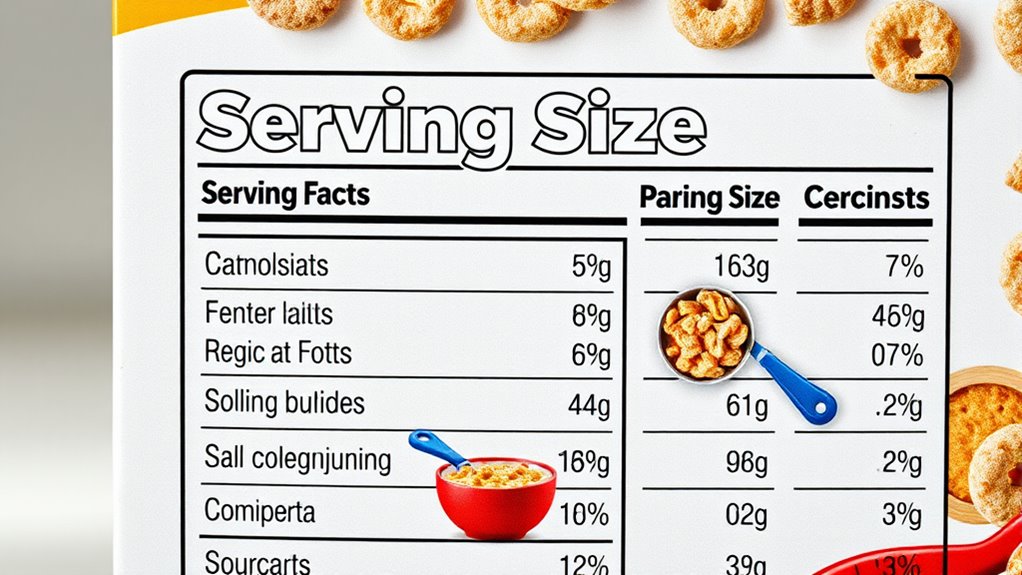
Have you ever wondered why the serving size on a nutrition label doesn’t match how much you usually eat? It’s because serving sizes are meant to provide portion clarity and maintain label consistency, not necessarily reflect what you personally consume. Understanding this distinction helps you make better choices without confusion. Serving sizes are standardized to allow for easy comparison between products, but your portion may be larger or smaller. Always check the serving size listed, then adjust the nutrition information accordingly. This way, you won’t underestimate your intake or misjudge calories and nutrients. Remember, the goal is to interpret labels accurately, so you can better manage your diet and avoid surprises. Clear portion understanding is key to making informed, healthier decisions. Additionally, being aware of macronutrient ratios can help you stay on track with your dietary goals.
Reading Calories and Macronutrients
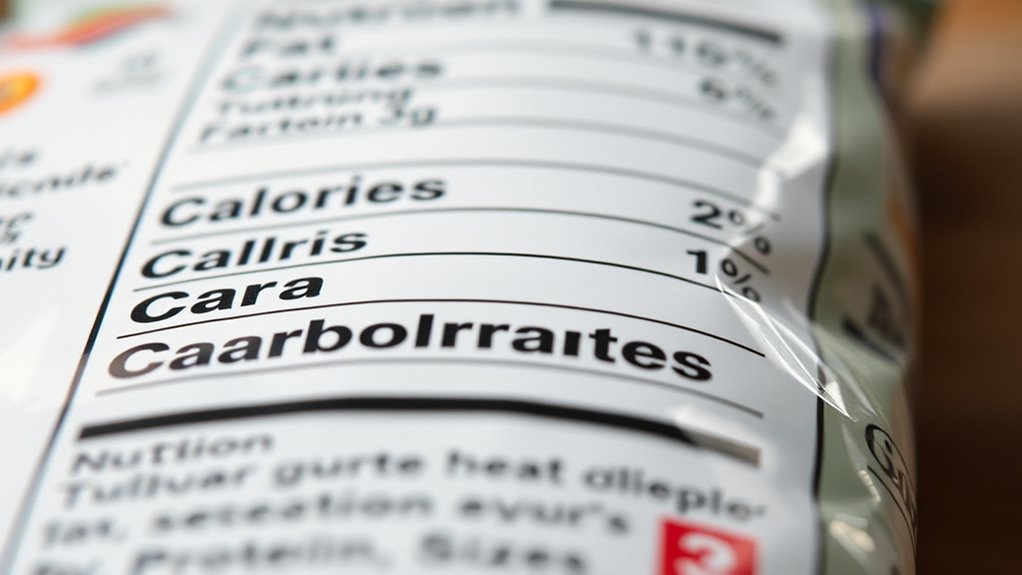
Understanding how to read calories and macronutrients on a nutrition label is essential for managing your diet effectively. When you look at the label, focus on calorie counts to control your overall energy intake, which is key for weight management. Pay attention to the macronutrient ratios—carbohydrates, proteins, and fats—to ensure your diet is balanced. If you’re calorie counting, note the serving size to accurately track your intake. Comparing the calories from macronutrients helps you see if your meal aligns with your nutritional goals. Remember, a higher protein content can support muscle growth, while monitoring fats and carbs helps maintain energy levels and overall health. Mastering these details empowers you to make informed food choices.
Analyzing Ingredients List
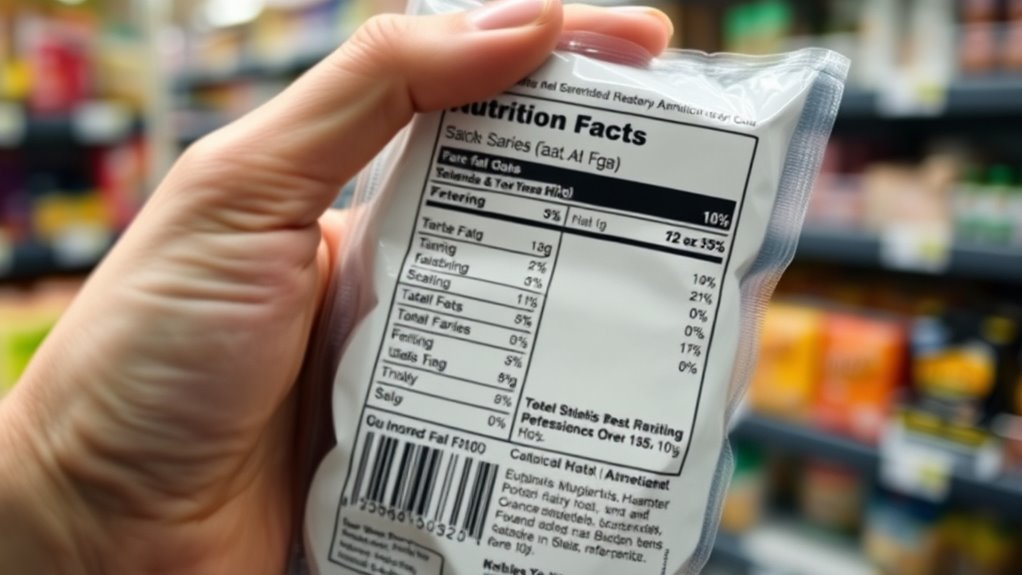
The ingredients listed on a package are ordered by quantity, so what appears first is what’s most prevalent. Pay close attention to the placement to understand what’s truly in your food. Also, look for additives and preservatives, and recognize them clearly to make healthier choices.
Ingredient Order Matters
Since ingredient lists are arranged by quantity, the items listed first are the most abundant in the product. Pay attention to this ingredient hierarchy because it reveals what’s truly in your food. Ingredients at the top of the list matter most, so if sugar or unhealthy fats are near the beginning, you’re consuming more of them. This order also highlights additive significance; additives listed further down are present in smaller amounts. Recognizing the order helps you make smarter choices and avoid products with questionable ingredients in large quantities. Always check the first few ingredients to understand the product’s core composition. Remember, an ingredient’s position isn’t just about quantity but also about potential health impact, so prioritize products with wholesome ingredients higher on the list. Additionally, understanding the benefits of reading labels carefully can help you make informed dietary decisions that promote better health.
Identify Additives Clearly
Have you ever wondered what all those strange words and chemical names on the ingredient list actually mean? To identify additives clearly, focus on these key points:
- Look for artificial sweeteners like aspartame or sucralose, often hidden under code names.
- Check for preservative types such as sodium benzoate or BHA that extend shelf life.
- Recognize common additive names, including flavor enhancers or colorings, to understand their purpose.
- Be aware of unfamiliar ingredients—research them to see if they’re artificial or natural.
- Understanding the use of additive technology can help you better interpret ingredient lists and make informed choices.
Identifying Hidden Sugars and Additives
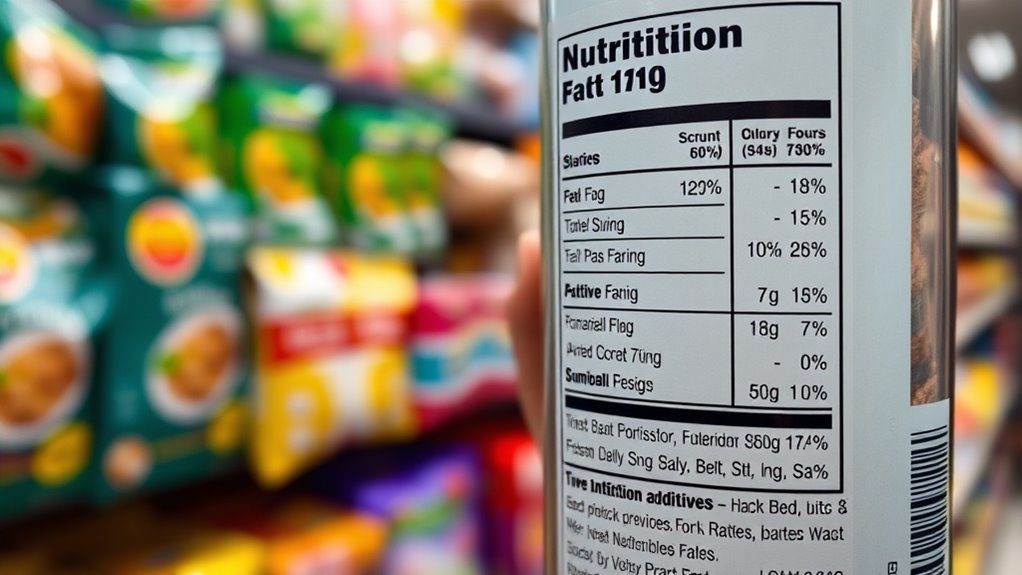
Many processed foods contain hidden sugars and additives that can boost calories and impact your health. By recognizing common additives like preservatives and artificial sweeteners, you can make smarter choices. Learning to spot these ingredients helps you avoid added sugars you might not notice at first glance. Incorporating vetted products into your shopping routine can further help you select healthier options.
Recognizing Common Additives
Hidden sugars and additives often lurk in processed foods, making it tricky to know what you’re really eating. To spot common additives, look for these on labels:
- Artificial flavors – synthetic substances designed to mimic natural tastes.
- Preservative types – chemicals like sulfites or benzoates that extend shelf life.
- Color additives – artificial dyes such as Yellow 5 or Red 40.
- Sweeteners – sugar substitutes like aspartame or sucralose.
Recognizing these ingredients helps you avoid unwanted additives and make healthier choices. Always check ingredient lists for unfamiliar or lengthy names. Pimple Patch ingredients are formulated for targeted skin benefits, making them a useful addition to your skincare routine. Remember, many additives are used to enhance flavor, appearance, or shelf stability, but they aren’t always beneficial for your health. Being aware of common preservatives and artificial flavors allows you to make more informed decisions about what you eat.
Spotting Hidden Sugars
While reading nutrition labels, it’s easy to overlook sugars that are hidden under confusing names or terms. Manufacturers often use alternative names for added sugars, such as high-fructose corn syrup, agave nectar, or evaporated cane juice. Be aware of natural sweeteners like honey, maple syrup, or agave syrup, which can also add sugar content. Additionally, sugar alcohols like sorbitol, maltitol, and xylitol are common in sugar-free products, but they still contribute to your overall sugar intake. Check the ingredients list carefully—ingredients listed near the top usually indicate higher amounts. Recognizing these hidden sugars and additives helps you make smarter choices and avoid consuming more sugar than you realize. Staying vigilant ensures you stay aligned with your health goals. Understanding food ingredients can further help you identify hidden sources of added sugars in packaged foods.
Recognizing Nutrient Percent Daily Values
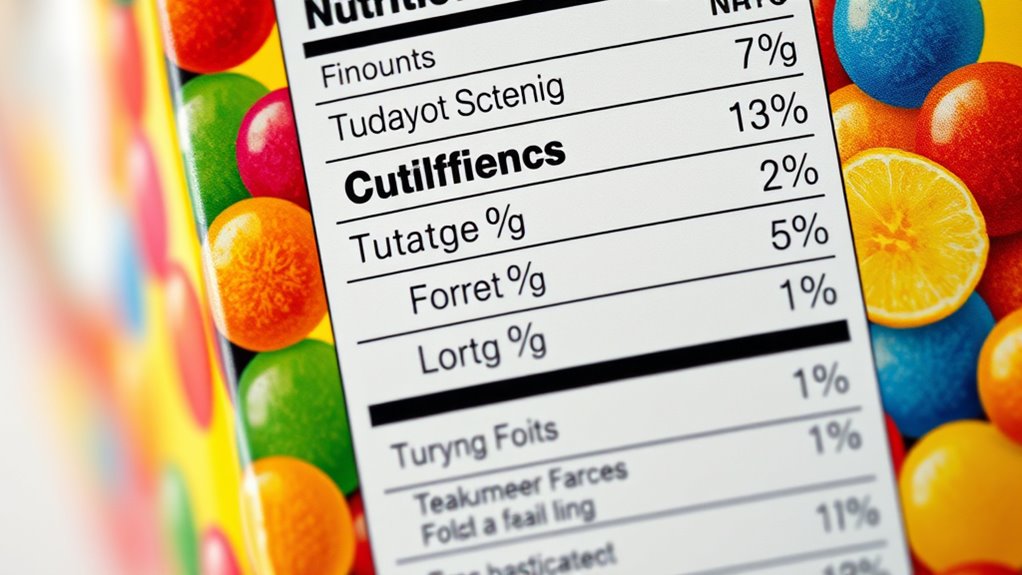
Have you ever wondered what the percentages on a nutrition label truly mean? Those numbers show the nutrient percentage significance based on your daily value interpretation. Here’s what to know:
- Understanding the % Daily Value helps you gauge if a food is high or low in a specific nutrient.
- A 5% or less indicates a low source, while 20% or more signifies a high source.
- These percentages are based on general daily recommendations, but your needs may vary.
- Use the percent daily values to compare products and make healthier choices quickly.
- Recognizing spoiled lemon juice can help you avoid consuming expired products that might mislead the label’s nutritional info.
Recognizing nutrient percent daily values empowers you to interpret labels effectively, ensuring you meet your nutritional goals without overdoing certain nutrients.
Comparing Products Effectively
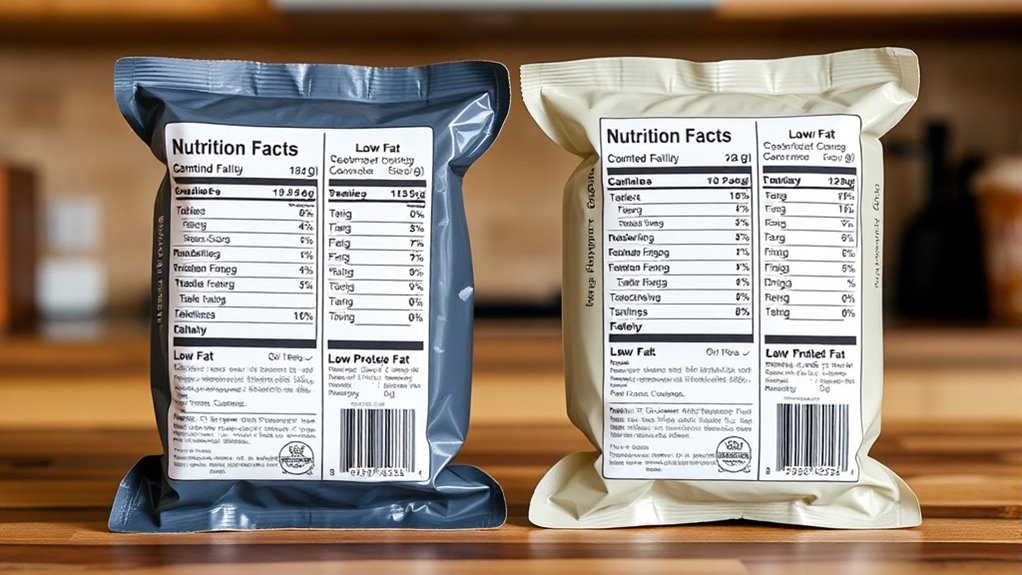
Comparing products effectively requires paying close attention to the nutrition labels and their % Daily Values. When doing a label comparison, focus on serving sizes to guarantee you’re comparing similar amounts. Look beyond front-of-package claims and evaluate the actual nutrient content, such as sugar, fat, and protein. Brand evaluation involves checking for consistency across different products and selecting options with lower saturated fat, added sugars, and sodium. Don’t just compare the labels side-by-side; consider overall nutritional quality. Use the % Daily Values as a guide to determine which product aligns better with your dietary goals. Additionally, understanding the horsepower of electric dirt bikes can help you assess the energy content and performance features relevant to your needs. This approach helps you make smarter choices, assuring you pick healthier options based on factual information rather than marketing claims.
Frequently Asked Questions
How Do I Interpret “Contains” Versus “Added Sugars” on Labels?
When you see “contains” versus “added sugars” on a label, it helps you understand sugar sources in your food. “Contains” lists all sugars from ingredients, including natural ones like fruit or milk. “Added sugars” are sugars added during processing, like syrup or cane sugar. Knowing label terminology lets you compare products better, so you can choose options with less added sugar for a healthier diet.
What Is the Significance of Trans Fats in Nutrition Labels?
Think of trans fats as the toxic weeds in your garden—they can harm your health silently. Trans fats implications include increased heart disease risk, so checking labels is vital. Labeling regulations now require manufacturers to list trans fats clearly, helping you spot and avoid them. By paying attention, you’re a vigilant gardener, keeping your health thriving and preventing harmful substances from taking root in your diet.
How Can I Identify Allergens in Ingredient Lists?
You can identify allergens in ingredient lists by carefully reading each item, looking for common allergens like nuts, dairy, or gluten. Be aware of allergen cross contact, which can happen during manufacturing, and look for notices about it. Watch out for hidden allergens, often listed under less obvious names. Always check for any allergy warnings or precaution statements to guarantee your safety and avoid allergic reactions.
Are Organic Ingredients Always Healthier Than Non-Organic?
Pondering whether organic ingredients are always healthier? Organic benefits include fewer pesticides and environmental advantages, making them appealing. However, non-organic drawbacks like potential pesticide residues and lower costs shouldn’t be ignored. You should consider your priorities—whether you value health, sustainability, or budget. While organic options often promote purity, they aren’t necessarily perfect or more nutritious. Ultimately, making mindful, informed choices helps you balance health benefits with practicality.
How Do Serving Sizes Affect the Overall Nutritional Value?
Serving sizes impact your understanding of nutritional value because they influence portion control and serving frequency. When you see a larger serving size, it might seem healthier, but it could contain more calories, fat, and sugar. Paying attention to serving sizes helps you manage portions better, avoid overeating, and make smarter food choices. Always compare the serving size to what you actually eat to accurately assess the food’s nutritional impact on your diet.
Conclusion
Now that you know how to navigate nutrition labels, you hold the map to healthier choices. Think of labels as a treasure chest—each section revealing hidden gems or pitfalls. With this knowledge, you can steer clear of deceptive tricks and find the true essence of what you’re eating. Like a skilled captain, you’re now equipped to chart a course toward better health, confidently steering through the sea of food labels with clarity and purpose.
